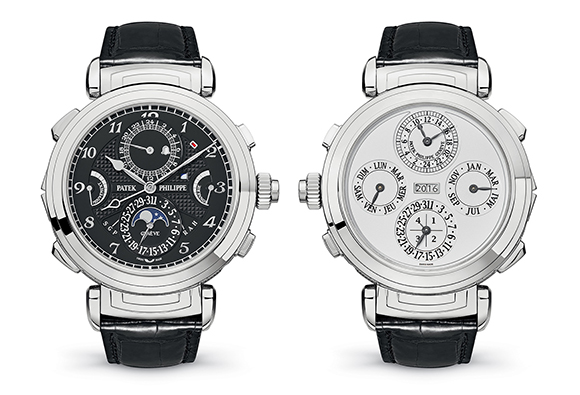The watch has its own special place in the vast domain of boys’ toys, and this is perhaps not such a good thing. Never before have so many ultra high-end watches been sold (except of course over the past year or so). But there is still a great divide between the world of watchmaking and the other world that it so desperately covets and with which it shares both its values and its fans: the world of the automobile. The differences are striking when you start to look at the top of the pile. For super complications on the one hand and supercars on the other, the rules are not the same.
First of all, what exactly are we talking about? In the world of automobiles, the trend is clearly towards an overdose of power, luxury and aggressive design. McLaren, Lamborghini, Ferrari, Aston Martin, Koenigsegg and AMG compete with V12 bi-turbo engines racking up 700, 800 and 900 horsepower. The 0-60 times for such cars are now below four seconds for scores of series-production models. The barrier of three seconds has also been broken. There is the same battle for hyperluxury, where the big saloon cars and SUVs from the British and the Germans are competing to offer the ultimate in comfort, in passive and active safety. There are around 15 well-known brands (excluding micro-brands in this world of superlatives) that offer vehicles that cost in excess of €200,000, with production volumes in the tens of thousands per year. There is nothing particularly surprising about any of this.
It is when you start to consider the motivations of customers for such vehicles when you start to scratch your head. These men (for the most part) think nothing of owning several cars that will never have a chance of going above second gear in urban traffic. Never. And that owning a Ferrari of which only 209 were produced, as is the case with the latest model to leave the Maranello plant, the LaFerrari Aperta, is a privilege given its V12 hybrid engine with its 949 horsepower. To such an extent that the entire production of this model was reserved before it was even launched. And this in spite of the delivery time, which can be measured in years. As a small aside, Bugatti owners own on average 42 cars, 1.4 yachts and 1.7 private jets. On average…

At the other end of the scale, there are around 50 watch brands that offer models costing in excess of €200,000 to grace a man’s wrist. A minute repeater and a tourbillon, or in some cases just one of these two complications, is enough to reach this level. It’s worth noting also that it is neither the gold (or platinum) used for the cases that is responsible for such figures. As François-Henry Bennahmias, CEO of Audemars Piguet, said in a recent interview, there is a huge amount of people who have an income in excess of seven figures who are completely unaware that they could buy a watch in excess of 30,000 US dollars! And even when you show them the proof, they cannot comprehend that such wrist accessories can cost the same as an Aston Martin. What would they say, therefore, when confronted with the grand complications of Patek Philippe, whose minute-repeater tourbillons cost in excess of 500,000 Swiss francs, and whose Reference 6300 Grandmaster Chime costs a cool 2.5 million Swiss francs? Would they have a heart attack in a Vacheron Constantin boutique when they hear that a Traditionnelle Calibre 2755 costs €750,000?

The world’s most exclusive, most powerful cars awake planetary interest, among the billionaires who buy them and those who can never even hope to see a Pagani Huayra on the road. As a result, their exorbitant prices are never called into question. Yet the treasures of ingenuity, meticulousness and micromechanics designed for our wrists face nothing but incomprehension among all but the most select circle of avid customers, whose number is estimated at around 20,000. Compare this to the estimated 30 million people around the world who, various studies claim, have disposable assets (i.e. money that they can spend) of more than one million US dollars.
Cars are everywhere. They project power, aggressiveness, desire. They stand out all the more since they embody something that is universally understood and appreciated: the freedom of movement and thus freedom in general. This association of concepts is beyond limits, whether they be on speed, traffic or regulations. Customers perceive cars as a form of protection (even though they can kill) that gives you driving pleasure (even if it is often restricted). Matched against the same criteria, watchmaking has nothing to offer. It is rarely seen, can only be examined up close, cannot be driven and takes you nowhere other than a world of dreams. A watch is an egotistical form of pleasure. People who share photos of their watches on social media rarely show their own faces out of fear of being robbed. Watchmaking is a world where a certain level of awareness is required to look beyond the 10 brands who might be spontaneously cited as producers of luxury timepieces. All the others often have to rely on the presence of their CEO or founder, whose words aid sales like no advertisement ever could. Even then, such purchases are often considered investments. Among watch retailers there is a tenacious urban myth that watches are indeed an investment. That is as may be, but only for an infinitesimally small percentage of them, and for the long term.
The watch industry therefore has a huge amount of evangelizing, advertising and educating to do. This needs to start in the mid to upper range but above all on the more sophisticated fringes of the industry, where things remain artisanal. Only here can a grand complication, a hyperwatch, come close to a supercar on one point: a reduction in price due to an increase in production volumes. A fabulous machine like the Porsche 911 GT3 RS costs “only” €180,000 because at least 300 of them are produced (probably much more in the end) in order to be homologated. No more than a handful of a horological equivalent such as the Audemars Piguet Royal Oak Concept Supersonnerie leave the workshop each year. Its exceptional level of hand finishing means its production simply cannot be scaled up to industrial levels, even if that production itself is based on industrial rules that are standardized and repetitive.

The injustice is, therefore, one which we have to live with. The watchmaking ecosystem is fragile and fragmented, especially at the top, where 20 brands are competing for customers who are willing to spend extreme amounts of money. On the other side of the fence, where the mechanics are based not on gear trains but on cylinders, where the mainplate is replaced by the chassis, the intimate and sensual relationship between the rich man and his car, between the (Sunday) driver and his machine seems unbreakable. Not even the widespread move towards electric propulsion or environmental concerns (which are easy to dismiss given the rarity of such vehicles and how little they are actually used) have an impact. And this is without even considering the auction market, where the stakes are the same but the intensity and the money involved even greater.







